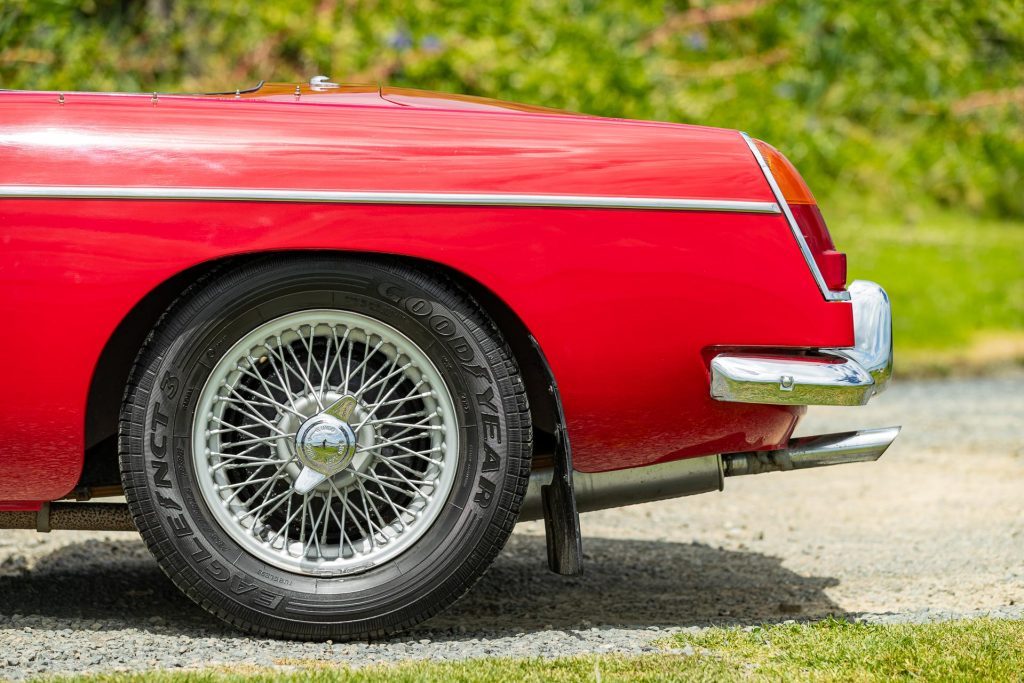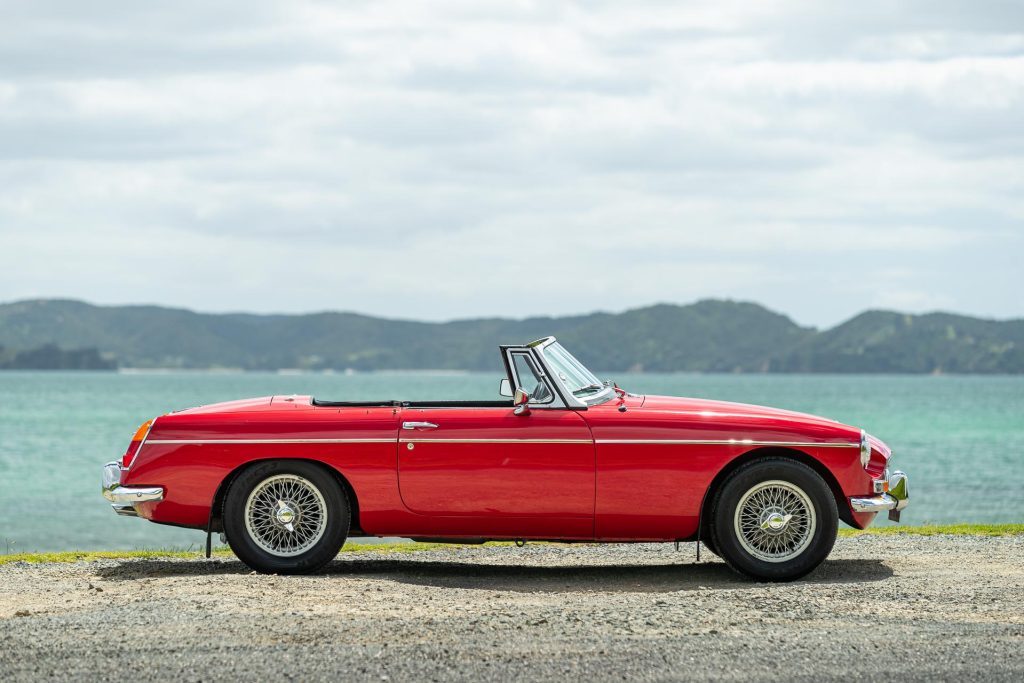1965 MG MGB Roadster
It would be hard to argue against the MGB being one of the most loved British cars ever.

It would be hard to argue against the MGB being one of the most loved British cars ever. And after 60 years, it’s still charming and finding a new generation of custodians.
MG is a different car company today compared with its post-war heyday. When the MG Rover Group went bust in 2005, Chinese firm Nanjing Automotive swooped in to scoop up the remnants of the British brand, including the old Longbridge factory.
Soon after, Nanjing was swallowed up by the state-owned giant SAIC.
But from the ashes of the old Brit, the new firm is in go-ahead mode, the brand now a regular in the top ten sellers list here in NZ thanks to its value-led product line-up, outselling the likes of Nissan, Mazda and Honda.
We jumped out of one of MG’s new machines, the MG4 XPower, into this MGB, sixty odd years separating the two. What a time warp.
From no noise, no gears, not even a starter button, back to pulling out the choke, twisting the key and being welcomed by the sound of an old four pot cranking into life.
It settles into a rowdy, lumpy idle, while the smells of the combustion process add another connection to the experience.
The MGB was phenomenally successful for the firm, one of BMC’s greatest hits. It was in production from 1962 through to 1980, some 514,000 produced all told, including the GT hardtop coupes.
The styling was all new when it appeared and the chassis too, a unibody construction, lighter and stronger than the body-on-frame formula of the MGA that this car replaced.
However, in typical BMC fashion, components like the brakes (front discs, drums on the rear) and the suspension were carried over from the A and adapted. The engine was also recycled, the firm’s B Series OHC four cylinder pressed into service.
It dated back to the mid-50s, though was enlarged from 1622 to 1798cc for the MGB. With a pair of 1.5-inch SU carburettors on its side, it made around 95hp with 150Nm of torque, the latter from a leisurely 2500rpm.
It could rev to 6000rpm before the valves started to bounce.
But before we get to that, finding reverse is the first challenge. You pull up on the stubby lever and back down to the left. Drive is engaged via a lightweight and feelsome clutch, the lithe B moving about easily, no real muscle needed on the unassisted steering wheel.
Finding first gear is tricky too; it’s straight ahead rather than across and up, and this being an early car, there’s no synchro (remember next time that I must be completely stopped before trying to snatch first).
First is super low, so too second, which helps give the MGB a sprightly feel off the mark. The push rod four has a torquey low end and a keen(ish) response.
Performance wise, the B was good for an 11sec 0-100km/h run, and could top 100mph, just. That would be quite something. Like most pushrod fours, it begins to get rather vocal past 4000rpm, and as it winds out past 5000 it seems like a good time to change gears.
The shift likes a delicate yet deliberate hand, and is better when it’s unrushed. The pedals aren’t especially well placed for any heel and toe antics but racy changes aren’t something you’ll want to be doing anyway.
MG1795’s happy place is at an indicated 55mph, the engine buzzing but happy at about 3500rpm in fourth, top. Given the torque, the low overall gearing, and sub-1000kg kerb weight, swapping between third and fourth keeps it cruising sweetly.
The ride isn’t too bad, though the lack of body rigidity in the roadster is felt over lumpy bits. With rack and pinion steering it turns with a relative immediacy for something of the era, the wheel loading up quickly with a full-of-feel character.
However, you have to take the good with the bad, as it can kick back through bumpy corners, such as it was back then.
While there’s some bump steer when the rear end hits a decent lump mid-corner, the handling is otherwise pretty sweet.
There’s a well balanced feel to its cornering, the front and rear ends working in unison and without any immediate threat that it’s going to roll into alarming oversteer without warning.
The brake pedal has a solid feel and, being unassisted, requires a decent effort to get the stoppers working. It reminds us how far braking tech has come.
The MGB’s driving position is sorted, pedals out in front and the cabin is spacious; you don’t feel hemmed in here. It’s a little bit tight when it comes to getting your right leg into the footwell but otherwise it’s all okay for a roadster.
It would be more of a challenge with the roof in place, we’d imagine, this particular car with both a touring hardtop and a fold-up fabric roof. It wasn’t until later in the car’s development that it got a proper folding soft top.
This car is an Australian assembled model, first registered here in 1965. Our owner, a self-confessed mid-lifer, has had MG1795 for about a year now.
It had been previously treated to a rebuild around 25 years ago by Rod Brayshaw’s MG Car Company of NZ, and been well kept by the typical MGB owner, who enjoyed taking it for a run down to the bowls club every now and again.
It’s now with its fifth owner who told us he’s loved the MGB since he was a kid.
“I got a book on the A-Z of Classic Cars, and it was always the MGB I’d go back to”. Also a lover of Alfas, he considered a Spider but he simply likes the styling of the MGB more, especially the rear end.
“There were a couple of Spiders for sale at the time, but they ask a bit more, and the MG had a hardtop.
“I get a bit of stick from people who say ‘why didn’t you get a good classic car?’ but I like the shape, there are heaps of spares for it, and it’s cheap to run and insure.”
Even his father-in-law gave him a bit of grief. “He’s a car guy and he said, ‘those MGs, they are so unreliable’ but it’s been around since 1965 and it’s still going pretty good. And it hasn’t given me any problems so far.”
While our owner says he won’t be joining the MG owners’ club anytime soon, he does love driving the car. “It’s my decompressor. While I don’t drive it every day, it gets well used in the weekends.
It’s noisy, it’s a manual and it’s a good break from spending all week at work. My girls love going for a drive in it too.”
We wonder if the same enduring affection the MGB enjoys will translate to the MG4 XPower in 60 years time? Somehow we don’t quite think so.
The briefest of MGB Roadster histories
The MGB was first launched as the Roadster in 1962, with the ‘three bearing’ 18G engine and pull-to-open door handles.
A year later, the firm offered an optional overdrive mechanism for the four speed manual along with a glass fibre hardtop.
One of the few engine upgrades came in 1964 with the more robust 18GB five-bearing engine, and the push button door handles came for the 1965 model.
A Mark II model emerged in 1967, the engine gaining an alternator in place of the old dynamo, a front sway bar was added, the manual gaining synchromesh on all four gears along with revised ratios.
Buyers could now opt for a three-speed Borg Warner auto and pay extra for radial tyres.
In 1969 the MkIII arrived with a new grille and better seats, while the wheels were new and a folding soft top added. Between 1970 and 1973 minor changes included a steel bonnet replacing the aluminium one, a new fascia for the dash and a restyled grille.
Servo assisted brakes made the grade in 1973. To meet safety regulations in the all important American market, the MGB had to ditch its chrome bumpers for the dreaded rubber jobbies, which also grew to include the grille area, giving the car an entirely new look.
The suspension was also raised 25mm in order to comply with new US headlight height regs.
This along with a deletion of the front sway bar on cost cutting grounds conspired to foul the dynamics.
In 1976, it received a minor facelift, while production ended in 1980 with a total of 386,789 being made.
View listings on Trade Me Motors: MG MGB
Also consider

















